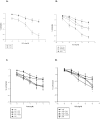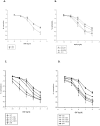Low-dose dextromethorphan, a NADPH oxidase inhibitor, reduces blood pressure and enhances vascular protection in experimental hypertension
- PMID: 23049937
- PMCID: PMC3457948
- DOI: 10.1371/journal.pone.0046067
Low-dose dextromethorphan, a NADPH oxidase inhibitor, reduces blood pressure and enhances vascular protection in experimental hypertension
Abstract
Background: Vascular oxidative stress may be increased with age and aggravate endothelial dysfunction and vascular injury in hypertension. This study aimed to investigate the effects of dextromethorphan (DM), a NADPH oxidase inhibitor, either alone or in combination treatment, on blood pressure (BP) and vascular protection in aged spontaneous hypertensive rats (SHRs).
Methodology/principal findings: Eighteen-week-old WKY rats and SHRs were housed for 2 weeks. SHRs were randomly assigned to one of the 12 groups: untreated; DM monotherapy with 1, 5 or 25 mg/kg/day; amlodipine (AM, a calcium channel blocker) monotherapy with 1 or 5 mg/kg/day; and combination therapy of DM 1, 5 or 25 mg/kg/day with AM 1 or 5 mg/kg/day individually for 4 weeks. The in vitro effects of DM were also examined. In SHRs, AM monotherapy dose-dependently reduced arterial systolic BP. DM in various doses significantly and similarly reduced arterial systolic BP. Combination of DM with AM gave additive effects on BP reduction. DM, either alone or in combination with AM, improved aortic endothelial function indicated by ex vivo acetylcholine-induced relaxation. The combination of low-dose DM with AM gave most significant inhibition on aortic wall thickness in SHRs. Plasma total antioxidant status was significantly increased by all the therapies except for the combination of high-dose DM with high-dose AM. Serum nitrite and nitrate level was significantly reduced by AM but not by DM or the combination of DM with AM. Furthermore, in vitro treatment with DM reduced angiotensin II-induced reactive oxygen species and NADPH oxidase activation in human aortic endothelial cells.
Conclusions/significance: Treatment of DM reduced BP and enhanced vascular protection probably by inhibiting vascular NADPH oxidase in aged hypertensive animals with or without AM treatment. It provides the potential rationale to a novel combination treatment with low-dose DM and AM in clinical hypertension.
Conflict of interest statement
Figures








Similar articles
-
Combination With Low-dose Dextromethorphan Improves the Effect of Amlodipine Monotherapy in Clinical Hypertension: A First-in-human, Concept-proven, Prospective, Dose-escalation, Multicenter Study.Medicine (Baltimore). 2016 Mar;95(12):e3234. doi: 10.1097/MD.0000000000003234. Medicine (Baltimore). 2016. PMID: 27015224 Free PMC article. Clinical Trial.
-
Chronic administration of genistein improves endothelial dysfunction in spontaneously hypertensive rats: involvement of eNOS, caveolin and calmodulin expression and NADPH oxidase activity.Clin Sci (Lond). 2007 Feb;112(3):183-91. doi: 10.1042/CS20060185. Clin Sci (Lond). 2007. PMID: 17007611
-
Quercetin downregulates NADPH oxidase, increases eNOS activity and prevents endothelial dysfunction in spontaneously hypertensive rats.J Hypertens. 2006 Jan;24(1):75-84. doi: 10.1097/01.hjh.0000198029.22472.d9. J Hypertens. 2006. PMID: 16331104
-
Beneficial effects of pioglitazone on hypertensive cardiovascular injury are enhanced by combination with candesartan.Hypertension. 2008 Feb;51(2):296-301. doi: 10.1161/HYPERTENSIONAHA.107.099044. Epub 2007 Dec 24. Hypertension. 2008. PMID: 18158350
-
A Combination of Intravenous Genistein Plus Mg2+ Enhances Antihypertensive Effects in SHR by Endothelial Protection and BKCa Channel Inhibition.Am J Hypertens. 2015 Sep;28(9):1114-20. doi: 10.1093/ajh/hpv005. Epub 2015 Feb 24. Am J Hypertens. 2015. PMID: 25714131
Cited by
-
Novel Approaches to Restore Pancreatic Beta-Cell Mass and Function.Handb Exp Pharmacol. 2022;274:439-465. doi: 10.1007/164_2021_474. Handb Exp Pharmacol. 2022. PMID: 34114119 Review.
-
DNA damage and augmented oxidative stress in bone marrow mononuclear cells from Angiotensin-dependent hypertensive mice.Int J Hypertens. 2013;2013:305202. doi: 10.1155/2013/305202. Epub 2013 Feb 14. Int J Hypertens. 2013. PMID: 23476745 Free PMC article.
-
An In Silico Study of the Antioxidant Ability for Two Caffeine Analogs Using Molecular Docking and Quantum Chemical Methods.Molecules. 2018 Oct 29;23(11):2801. doi: 10.3390/molecules23112801. Molecules. 2018. PMID: 30380600 Free PMC article.
-
Combination With Low-dose Dextromethorphan Improves the Effect of Amlodipine Monotherapy in Clinical Hypertension: A First-in-human, Concept-proven, Prospective, Dose-escalation, Multicenter Study.Medicine (Baltimore). 2016 Mar;95(12):e3234. doi: 10.1097/MD.0000000000003234. Medicine (Baltimore). 2016. PMID: 27015224 Free PMC article. Clinical Trial.
-
Prevention of Hippocampal Neuronal Damage and Cognitive Function Deficits in Vascular Dementia by Dextromethorphan.Mol Neurobiol. 2016 Jul;53(5):3494-3502. doi: 10.1007/s12035-016-9786-5. Epub 2016 Feb 18. Mol Neurobiol. 2016. PMID: 26887382
References
-
- Kearney PM, Whelton M, Reynolds K, Muntner P, Whelton PK, et al. (2005) Global burden of hypertension: Analysis of worldwide data. Lancet 365 ((9455)): 217–223. - PubMed
-
- Ong KL, Cheung BM, Man YB, Lau CP, Lam KS (2007) Prevalence, awareness, treatment, and control of hypertension among United States adults 1999–2004. Hypertension 49 ((1)): 69–75. - PubMed
-
- Ezzati M, Lopez AD, Rodgers A, Vander Hoorn S, Murray CJ, et al. (2002) Comparative Risk Assessment Collaborating Group. Selected major risk factors and global and regional burden of disease. Lancet 360 ((9343)): 1347–1360. - PubMed
-
- O'Connor PJ (2006) Improving medication adherence: Challenges for physicians, payers, and policy makers. Arch Intern Med 166 ((17)): 1802–1804. - PubMed
-
- Hung CL, Liu CC, Yeh HI, Ko HJ, Hou CJY, et al. (2009) NT-ProBNP but not high sensitivity crp independently predict abnormal exercise duke score in well-controlled hypertension and pre-hypertension - An study from the subjects undergoing health evaluation. Acta Cardiol Sin 25 ((1)): 7–17.
Publication types
MeSH terms
Substances
LinkOut - more resources
Full Text Sources
Medical

